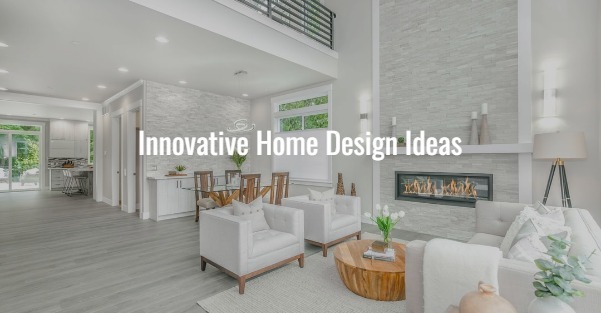
Every home needs a good dose of innovative design. A great home starts with a careful study of how people live. Then, thoughtful details, such as open floor plans and flexible living areas, are added. A house can also be livable, sustainable, or simple, depending on your preference. But what exactly makes a home innovative? What’s the key to creating a home that everyone will love? It all starts with an understanding of the way people live, and incorporating innovative design ideas that make everyday life easier and more enjoyable.
Innovative Home Design Ideas
Livable design
A livable home design meets several key criteria. It has a consistent floor plan and features that are accessible to all members of the household. For example, a livable home should feature a level entry and internal doors, as well as a stair-free toilet and shower recess. All rooms and services must also be accessible to people with limited mobility. The guidelines outline the 15 key elements that make a home livable, and describe the requirements for accreditation.
This design also addresses the needs of older people, including the disabled and elderly. It has wider doors and wider corridors to make moving furniture easier. Additionally, livable homes are safer for people with temporary injuries, such as fractures or dislocations. In addition, they accommodate the needs of the aging population, who need more accessible homes to age comfortably. Furthermore, the design also enables future generations to stay in a home, while still maintaining the independence of all members.
The guidelines provide useful information for both homeowners and builders. These guidelines can also be applied to existing homes during renovation. The Livable Housing Design Guidelines provide an overview of the 16 elements of a livable home. They are also designed to be easy to apply. The guidelines are based on the National Dialogue on Universal Housing Design. Livable Housing Australia uses the guidelines for home design, and Livable Housing Australia also provides more details on home design. For more information, you can visit the website or speak with an HIA Building Services advisor.
The exterior of the home can also be a significant factor in livable design solutions. Exterior home improvements are one way to make your home more attractive to the eyes and satisfy the neighbors. Make sure your entryway is 36 inches wide. Also, make sure that the entrance is wide enough to accommodate people with disabilities. Livable home design solutions can provide your home with better functionality. They will not only make your life easier, but they’ll give you a competitive advantage over your competitors.
Sustainability
Sustainable homes are becoming more popular as energy costs increase, awareness about climate change and wider economic uncertainty grow. Sustainable homes focus on building materials, reducing energy and water use, improving indoor air quality, and deploying systems to protect biodiversity and ecosystems. These homes are also designed to provide healthy living spaces. Several aspects of sustainable design are discussed below. Let’s take a closer look at some of the most common approaches to sustainable construction.
One example of sustainable home construction is the tiny house concept. This 22-square-meter space has a kitchen, bathroom, dining room, and sleeping space for four people. It also runs entirely on renewable energy. The home was designed to illustrate the ability to live within a small space while preserving the quality of life it offers. The Sullivans had two children in college, so they decided to downsize. To meet their financial and environmental needs, they designed a tiny house that was 22 square meters in size.
In addition to energy efficiency, green building materials include materials that are more recyclable. For example, recycled linoleum flooring is less expensive than wood and has improved in appearance. And while renewable energy sources are hot topics these days, a sustainable home requires smart water management. Using locally grown materials is a good start. For flooring, try linoleum, which has been around since the 80s. A great company to look for is Aeroseal.
One home that makes use of sustainable technology is the Prefabricated Accessible Technological House by Philippe Starck and the Slovenian prefab firm Riko. It is a sustainable home that uses a variety of sustainable technologies, including a solar array, wind turbine, and rainwater collection system. The resulting homes are also off-the-grid. And they’re a great way to reduce energy use and carbon footprint, without sacrificing comfort or style.
The first step towards sustainable home design is reducing the amount of waste generated during construction. Using thermostats and low-flow toilets reduce water waste and water bills. Traditional toilets use 6 liters of water per flush, while low-flush toilets require just 4.5 liters. Recycling old furniture is another great way to cut down on waste and save trees. Another aspect of sustainable house building is using plant-based paint. Chemical paints have negative effects on occupants and contribute to air pollution.
Minimalism
Incorporate green indoor plants in minimalist home design for a fresh look. But make sure to balance them with the room’s structure. Even small planters can give a minimalist room a pop of green. Keep in mind that minimal decor requires fewer objects and accessories. And it’s best to use smaller ones for small spaces. Minimalist homes can have more neutral color palettes. But if you want to incorporate more color, you can add accents such as artwork or accessories.
When incorporating minimal elements into your home design, you should use light colours or pastels to enhance your space. However, if you do choose bright colours, you should stick to one or two colours. A marble table, for example, can add a luxurious touch to the minimalist look. Minimalist homes are also more spacious and airy. They are also cozy due to natural light. If you’re going for a modern minimalist look, you can opt for a minimal yet chic look that won’t break the bank.
Keeping your home simple and uncluttered will help you reduce your stress levels. Including family pictures and mementos is a good idea because it makes you feel grounded. On the other hand, a minimalist home may leave you feeling empty and unsatisfied. You’ll have to be a bit creative to incorporate this idea into your home design. You can add shelves to bare walls, place an ottoman on the floor or create a floating shelf.
A minimalist home design can also encourage you to reduce clutter by getting rid of excess items. Instead of having multiples of items, try to keep only the things you need. You can even store toilet paper in creative ways. Minimalism is not for everyone. It’s good for the environment. You can choose a minimalist home design that fits in with your style and your needs. It’s a great way to make your home more beautiful and comfortable.
If you’re planning a minimalist home design, you may want to keep your walls and floors neutral. Avoid bright colors as they may overpower your space. Natural materials such as wood, stone, and even tile are great choices for minimalist homes. However, if you have a lot of colorful items, you can also incorporate a few splashes of color for a personal touch. This way, your home will feel personal and unique.
Mobility
The World Economic Forum is working to develop universal mobility principles that will help elevate the conversation about accessibility and inclusion in our daily lives. These principles will provide a common language for city transportation leaders, commercial mobility providers, and civil society leaders to work toward the same goal of improving mobility and independence for all. The goal is to make it possible for people to access all parts of the home regardless of their physical or mental abilities. The following are some of the principles that will be important to these groups.
Many homes can’t be built with wheelchair accessibility in mind. That’s why there’s a growing number of accessible homes on the market. The key is incorporating innovative home design into your home. These homes are adaptable and can be wheelchair and pushchair accessible. There are many benefits to this type of design, and many of these features are available at low costs. As the nation’s population ages, the number of disabled people increases. While the Americans With Disabilities Act aims to promote equality in public spaces, many private homes lack basic accessibility features for people with varying levels of mobility. By including universal design elements in new building plans and remodels, you can ensure that people of varying mobility can safely live and move around in your home.
One way to create accessible homes is to include a room elevator in your home. The accessibility of an elevator is one of the most important factors for older homeowners, so you’ll want to have one if you have a disability. Another option for accessible housing is to build non-load-bearing interior walls. This will allow you more flexibility in renovating the home. In addition, a non-load-bearing interior wall will help you create a flexible floor plan and layout that will accommodate the needs of older homeowners.
The statistics surrounding the number of disabled people are dispiriting. However, innovation is often born out of a time of need, urgency, or economic transition. By using accessible transportation, people with disabilities can extend their independence well into old age. There are six promising innovations in mobility design that are worth a look. These six products have the potential to make life better for everyone. The possibilities are endless, and we have yet to see them in action.





